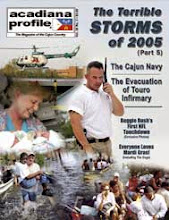Charles Edward Hamilton, M.D: A Beloved Acadiana Pediatrician Named “Uncle Charlie.”
In 1913, when Dr. Charles Hamilton first began making house calls on horse back in Coulee Croche, Louisiana, he was a twenty-three year old man of medicine with a desire for adventure.
Hamilton’s first contract assignment as a doctor came in 1915 when he accepted a job working in a hospital for a British oil company stationed in Tuxpam, Mexico. While in Tuxpam, one terrible afternoon Hamilton and some of his medical associates were captured by Mexican revolutionaries who forced them to stand in a line to be executed by a firing squad. Although Hamilton escaped being shot by running away, he soon found himself aboard an oil tanker that nearly sank during a monstrous hurricane.
After this hair-raising episode, three years later young Dr. Hamilton’s desire for foreign experiences would eventually bring him to the bloody World War I battlefields of France and Belgium.
But before that adventure could begin, back in quiet Coulee Croche (near Cankton), Hamilton lived with his mother, Josephine Gardiner Hamilton, and continued his horse and buggy general practitioner business from 1916 to early 1918. Hamilton’s father, George Carlisle Hamilton, a New Orleans steamboat captain, died many years earlier in 1892 when Charles was just two years old, the youngest of three brothers.
When young Hamilton was old enough to enroll in university level studies, Josephine’s brother, Dr. Charles Gardiner, gladly agreed to be his liberal arts and medical school benefactor. In 1909 Hamilton received his undergraduate degree in Liberal Arts at Jefferson College in Convent, LA, and in 1913 he earned a medical degree in Medical Arts and Sciences from Tulane University Department of Medicine.
On April 6, 1917, President Woodrow Wilson declared war against Imperial Germany and agreed to an urgent request by the British to supply American doctors to serve with the British Expeditionary Forces in France. In September of 1917, Hamilton read about the virtues of enlisting with the British in the magazine Journal of American Medical Association and promptly mailed his enlistment papers to the U.S. Army Medical Reserves Corps. He reassured his worried mother and Uncle Charles he didn’t expect the Army would accept him.
His humble doubts proved unfounded when on January 18, 1918, Hamilton received a momentous letter that would alter his life forever. In the letter, the U.S. Army expected him to report for duty within two months to serve as a doctor in the service of the British Expeditionary Forces. Also, he was now to be referred to as 1st Lieutenant, Charles Hamilton, M.C.
During his time of medical service to the British on the front lines of the war, Hamilton would be wounded twice, earn a promotion to the rank of Captain, and receive the British Medal of Victory for his service to the British Expeditionary Forces.
After the war Hamilton returned to practice medicine in Church Point, LA, and eventually found a wonderful wife named Ruth Mouton, whose tireless leadership in the preservation of Cajun and Creole heritage and revival of the French language would eventually earn her the titles Queen of the Acadians and “Tante Ruth” (Aunt Ruth). The couple had three daughters who grew up here in Lafayette.
In 1920, Hamilton formed a medical doctor partnership with two doctors that would be the first chapter of a career-long endeavor to give his patients the benefit of group consultation with his partner doctors at no additional cost. Hamilton’s idea of group consultation at no extra cost was - and continues to be - an innovative improvement in health care.
While attending a clinic at Massachusetts General Hospital in 1922, the general practitioner Hamilton took a fateful course in pediatrics that would inspire his lifelong devotion to children’s health. And at some point during his forty years of pediatric practice delivering hundreds of babies, Hamilton earned his patient’s affection and eventually he became known as “Uncle Charlie.”
By 1945, Hamilton had already relocated his doctor partner practice to Lafayette. His four-doctor organization was now known as the Lafayette Medical Surgical Group located on St. John at the Lafayette Sanitarium. Hamilton was Chief of Staff. By 1968, Hamilton’s group of doctors numbered 46.
Five years earlier, in 1963, Lafayette Sanitarium was relocated to the Oil Center and renamed Lafayette General Hospital. In 1971, Hamilton’s organization of doctors at Lafayette General incorporated and renamed their affiliation Hamilton Medical Group, in honor of Dr. Hamilton.
When Hamilton died in May of 1978, at the age 88, he had many admirers.
One admirer, Dr. Zerben Bienvenue, a fellow Lafayette doctor in partnership, recalls Hamilton as being “very much a gentleman. Very thoughtful, and an avid reader.” Bienvenue also recalls Hamilton as being a huge fan of prizefighting and baseball.
In 1984, Dr. Jerome Romagosa published an essay in which he characterized his dear friend Hamilton in this way: “He was not only a well-trained physician, but he was a cultured and scholarly gentleman of the old school.”
And in 1978, Hamilton’s friend Dr. J.J. Burdin said, “No one ever contributed more to medicine in Southwest Louisiana than Dr. Hamilton.”
Throughout his long life Dr. Charles Hamilton was said to have displayed the same familiar admirable traits that were forged in him during the Great War: he was the well-informed citizen, the concerned physician, the warm host, and the loyal friend.


<< Home